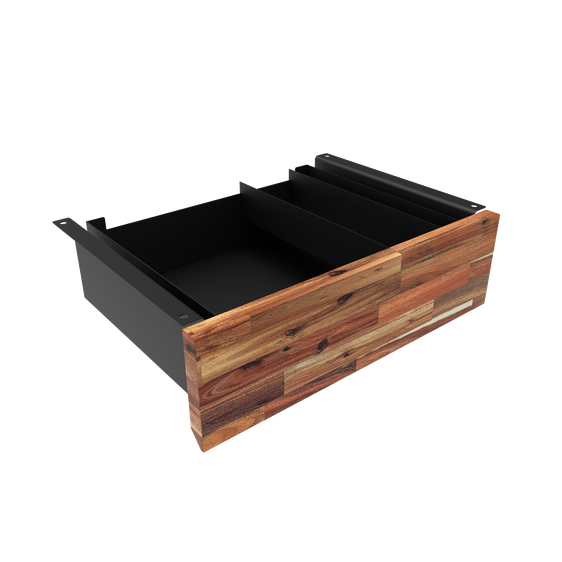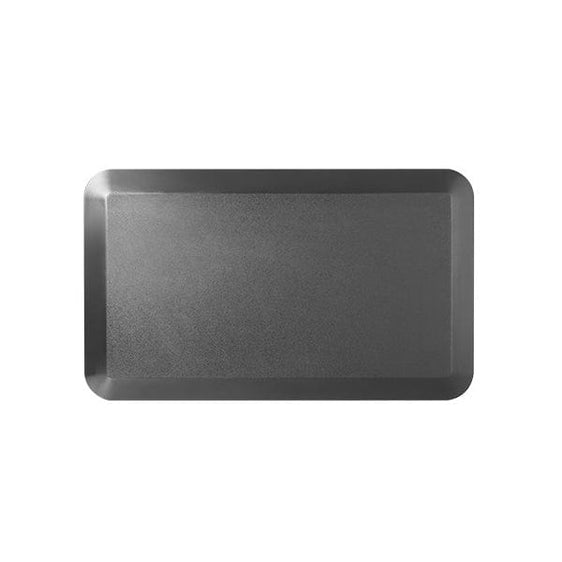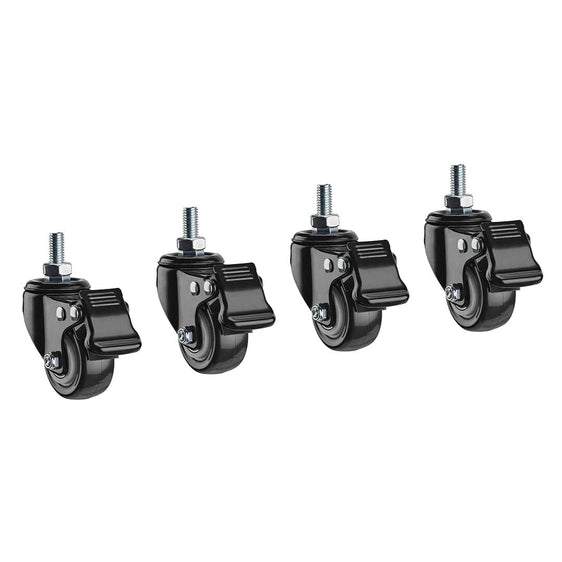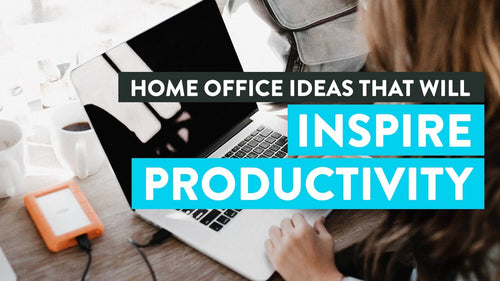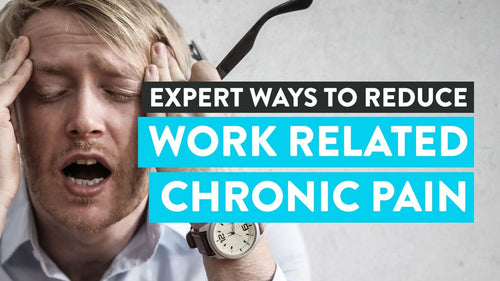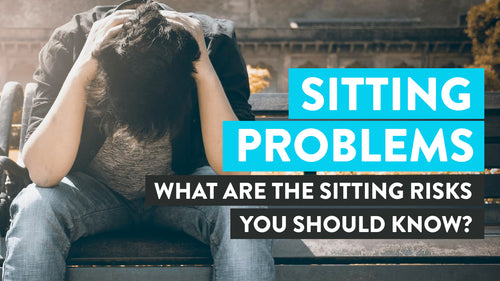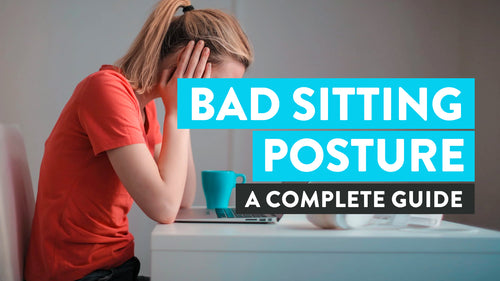
News
Lower Back Pain From Sitting at Desk: Everything You Should Know
Hayden AdamsYou've probably experienced back pain after sitting at your desk for hours. This issue is especially widespread in our current era of desk jobs and working from home.
This will lead to many problems. These include chronic back pain, lower brain function and energy levels, and increased risk of heart disease.
As such, addressing it will let you work more efficiently and safely.
Today, we'll talk about all you need to know about back pain — from its causes to tips on avoiding them.
Causes of Lower Back Pain from Sitting at the Desk
You're right in thinking that lower back pain from sitting at a desk is mainly from bad posture. However, other things can factor in as well.
We've listed and discussed these other causes below:
Poor Posture
Poor sitting posture at a desk for prolonged periods is one of the leading causes of body pain.
One example of poor posture is slouching too much to look at a computer screen, leading to upper back and neck pain.
Your head weighs around 12 pounds, so spending too long in one posture strains your neck to provide complete support in keeping your head in the same position.
Fatigue can further tempt a person to slouch more to relax.
This might feel comfortable. However, this posture can stretch your spinal ligaments too much, creating more tension and stress on your spinal discs.
Good posture extends to talking on the phone. Holding the phone between your shoulder and ear for a long period can leave more tension on your neck and spine.
Inadequate Ergonomics
Messy workstations can't encourage good posture. Furthermore, working in confined quarters can also create tension in the muscles.
For instance, not positioning your computer screen well can lead to a strained neck and shoulders. It might be because you have your head facing forward or backward too much.
Back pain from your upper spine can also be from strained movements and frequent twisting to reach office supplies.
An office chair without good lumbar support can also cause body strain.
{{ spec_elite_chair }}
Muscle Imbalances
You can encounter many kinds of muscle problems from sitting too long.
Office workers can experience neck pain and muscle weakness from sitting down while bending and twisting just the upper body.
Another problem is sciatica, which affects your sciatic nerve. This causes you to feel a dull ache or shock from the base of your spine to the back of the legs on one side.
Lower pain and strained spinal discs can also stem from a herniated disc. This is a serious problem where a disc has been pushed out of its position due to aging, poor lifting, or a repetitive injury.
Lower back muscle or lumbar strain can also occur from excessive stretching or twisting your back. That's because it stiffens your back, leaving chronic pain in your buttocks.
Another issue to be wary of is spinal stenosis. Here, your spinal canal is too small for the spinal cord to run through due to infection, injury, or congenital disability.
Fortunately, muscle strain can be resolved within a month. However, continuous poor posture would worsen it.
Lack of Movement
Sitting on an office chair without moving or stretching can lead to back pain. On top of that, staying in one position can decrease your body's general energy level.
A lack of movement leads to compressed and dried intervertebral discs, bulging spinal discs, and further pressure on spinal nerves.
The spine's characteristic numbness and tingly feeling are due to pinched spinal nerves, further exacerbated when sitting.
Body weight and atrophied muscles add further pressure on your spine, leading to more back pain. This will also make you feel like moving less too.
Health Risks Associated with Prolonged Sitting

Most adults would experience lower back pain at one point in life. This pain is due to your vertebrae L1-L5 being strained from bad sitting posture.
Back pain can range from sharp and sudden pain because of sudden movements to a long, dull ache that increases over time.
Back pain can also be a symptom of health risks tied to prolonged sitting — especially when you slouch forward for long periods.
Increased Risk of Chronic Pain
Most cases of back pain remain acute (lasting a few weeks) or sub-acute (lasting a few months) but are treatable with proper self-care.
However, up to 23% of people with acute back pain can soon evolve into chronic back pain as they age.
This development is further exacerbated by the time you spend sitting at your desk with bad posture, lack of exercise, and a poorly designed work surface.
Effect on Mental Health
Mental and physical health are intertwined. Because of that, stress and anxiety can actually worsen muscle tension and sensitivity to bodily pains.
This can also translate into low energy levels and poor cognition. That's because being sedentary for too long leads to low blood flow.
That's because your body isn't receiving all the nutrients and energy it needs to maintain good energy levels.
Reduced Cardiovascular Health
Poor posture can restrict the mobility of your thoracic cavity and diaphragm, lessening the air you can breathe.
This hinders proper oxygenation because the nerve isn't properly stimulated due to poor posture and slouching.
On top of that, you'll experience low blood flow too.
Impact on the Digestive System
The decreased hemodynamics from a sedentary lifestyle can slow down your digestive system.
The digestive system needs blood to send back the digested nutrients, and lack of movement keeps your blood at a slow pace.
Fewer nutrients would be distributed through your body, and food will be stored as fat rather than converted to energy or muscle.
Tips to Manage Lower Back Pain from Sitting at the Desk

There are several strategies to maintain good posture that will also greatly improve your health.
With these, you'll be addressing knee pain while sitting while you also slowly open yourself to bigger steps, like getting used to regular exercise.
Adjust Your Office Chair and Workstation
A good work environment and an ergonomic office chair with the right lumbar support can improve your health.
A good standing desk will ensure you don't stay seated for too long. If you use it right, it can reduce or cancel out the risk that too much sitting presents.
Regardless of whether you're standing or sitting, keep your body in a neutral position at all times.
For instance, keep the top of your computer monitor at eye level. Or, when typing or using the mouse, keep your wrists straight.
{{ spec_monitor_stand }}
Prioritise Proper Posture
Good posture saves you from chronic back pain.
You can keep back muscles straighter by positioning your upper back along an imaginary straight line perpendicular to the ceiling.
Sitting with lumbar support is the best sitting position to relieve lower back pain you can try. This support can be in the form of an ergonomic chair, lumbar pillow, or even a simple rolled-up towel and cushion.
Thanks to that, aside from sitting comfortably, you also won't experience pain.
Optimal Desk Posture For Lower Back Ache
Maintaining an upright posture while seated, with shoulders retracted and lowered, the chin offset back, the stomach tucked in, and the lower spine gaining support, is crucial.
Your spine should uphold its neutral stance, portraying an overarching curve from front to back. Keep your upper arms parallel and your shoulders level as you create a curve in your lower back. Don't let your pelvis rotate forward to keep the curve; have your back stretch and lengthen further.
Tips to better posture:
- Keep shoulders relaxed and aligned over hips.
- Maintain the three natural curves of your back.
- Rest both feet flat on the floor.
- Avoid prolonged standing or sitting positions.
How To Sit For Long Hours Without Back Pain
Comfortably enduring long hours of sitting is achievable if you observe the essential office ergonomics fundamentals. These include:
- Ensuring your behind sits flush against the back of your chair.
- Employing a cushion to promote a slight arch in your lower back, discouraging any slumping as your energy levels drop during the day.
- Consider reading why standing desks could be better than sitting for less strain on your back, making your long work hours more comfortable.
Take Regular Breaks and Stretch
Frequent breaks after an extended period of sitting behind a desk will do wonders for your physical health as a small form of physical therapy.
Moving around improves blood flow. Meanwhile, stretching removes the pressure from your joints and muscles.
How To Relieve Pressure On Lower Back
Lower back pressure relief involves a balance between temperature therapies. Cold therapy helps to suppress inflammation and reduce swelling. Utilise a cold pack for 20-minute intervals throughout the day, ensuring breaks in between. This technique will diminish inflammation and subsequently distribute the pressure throughout your lower back muscles.
On the flip side, heat therapy helps with muscle relaxation, especially when you feel stiff or tense. A heat pack, used similarly to the cold pack, intermittently every 20 minutes, can promote muscle relaxation and consequently distribute the excess pressure. More information on these techniques can be found on health authorities' websites, like CCOHS.
Self-Releasing Lower Back
Self-releasing your lower back demands a high level of understanding of your body and its limits. Self-massages using foam rollers are a popular practice to release muscle tension and increase mobility.
Stretching exercises, especially in the mornings, can provide a significant boost for the day, ensuring your lower back stays relaxed. Regular exercise can boost the strength, flexibility, and overall health of your back muscles.
Strengthen Your Core
Exercise, better breathing techniques, and consistent sleep are key strategies to maintain your health in the long run. Strengthening your core, abdominal, and back muscles can support your spine and develop better posture in the long run.
How To Relax Lower Back When Sitting
Relaxing your lower back while seated involves a combination of correct posture and muscle relaxation techniques. Attempt to distribute weight evenly across both hips and keep your feet flat on the floor. Simplicity can sometimes be the key; therefore, periods of deep breathing can promote relaxation in the lower back area.
Investing in a chair such as the Desky Pro+ Ergonomic Chair with a well-designed lumbar support is also beneficial for the back and can enhance comfort levels while sitting.
Preventative Steps to Avoid Lower Back Pain
Around 20% of people would develop back pain within the first year of work. Furthermore, a study has found that 50-80% of people will inevitably experience this in their lives.
Fortunately, you can avoid back pain and prevent shoulder discomfort during desk work from your office chair.
You can even alleviate rib pain from prolonged sitting in a desk job if you try to incorporate the following steps in your lifestyle:
Invest in an Ergonomic Office Chair
An adjustable desk chair makes your environment more efficient while maintaining your health.
Aside from a traditional office chair, you can actually try a Swiss exercise or balance ball since it encourages mobility.
However, you should still ensure proper posture to prevent back pain.
You can make yourself more comfortable and mobile with the following considerations:
- Calf measure check - With your buttocks pushed against the backrest forward, see if there is room for a cushion to support your back.
- Thigh measure check - Make sure you can slide your fingers under your thigh without it being too tight as you stay at the leading edge of the chair or use a footrest.
- Low back support - Add low back support from an extra cushion to prevent slumping.
- Elbow measure check - Make sure your elbows are at a 90-degree angle while parallel to the ground as your hands rest on the surface.
- Armrest checks - Ensure that your office chair's sides can lift your arms from the shoulders to prevent you from slouching forward or straining your back.
Best Office Setup For Back Pain
The ingredients of a lumbar-friendly office setup calls for a chair that cossets your spinal alignment. Fine-tuning your chair's height to a level that grants your feet contact with the floor or perhaps opting for a footrest that brings your thighs parallel to the ground can dramatically enhance your comfort.
A chair with adjustable armrests can invite notable relief. Place your arms lightly on armrests with elbows resting near your body, allowing your shoulders to de-stress. Harnessing these simple yet effective approaches can transform your workspace into a lower back pain-free oasis.
Use an Adjustable Standing Desk
{{ spec_dual_rubberwood_desk }}
An ergonomic space should allow you to reach everything within your office chair without excessive strain while encouraging good posture.
Follow these conditions to further encourage and maintain good posture:
- Within arm's reach - Keep everything within arm's length without slumping forward.
- Adjusted monitor height - Keep your monitor at eye level, as eye and head positions won't need to change so you don't strain your neck.
- Adjusted monitor brightness - Your body naturally tends to lean forward from your office chair due to low brightness.
- Adjusted desk or chair height - Your office chair should elevate you to your monitor's level, and your elbow should be bent at 90 degrees.
How To Set Up Desk To Avoid Back Pain
A proper desk setup plays a tremendous role in preventing back and neck discomfort. Fundamental factors to consider include the depth and height of your desk. A suitable desk is one that supports your forearms adequately; your elbows should not be left suspended. Read on how to use a standing desk correctly for more insights on reducing tension in your muscles making you more comfortable and less prone to back pain.
Position Your Monitor Correctly
In addition to your desk setup, monitor placement is also key. The top line of text on your screen should be at or slightly below eye-level. This placement will keep your neck and shoulders relaxed while reducing eye strain.
Keyboard and Mouse Positioning
Position your keyboard and mouse close to each other and ensure your wrists are straight when typing or using your mouse. This positioning reduces strain on your nerves and can help prevent conditions like carpal tunnel syndrome.
Incorporate Physical Activity into Daily Routine
Physical activity can prevent your body from building tension and stiffening muscles while you sit on your office chair.
Many exercises can be done behind a desk to promote blood flow and release tension in your body.
When you stay active, you can build some muscle and lose weight. You also keep your blood flowing for better energy and brain function.
Other exercises to prevent back pain you can do away from the desk are:
- Planks - Keep yourself in a pushup position for as long as possible. This helps strengthen your core muscles to support your back muscles too.
- Arch - Lie on your back, lift your lower section and abdominal muscles for a few seconds, and then relax.
- A 20-minute walk out of the office chair
Practise Mindfulness and Body Awareness
While working behind a desk, take plenty of breaks to stretch and move around.
Use this to regain a connection to better pinpoint where your body feels tense and to have a more focused relaxation.
Even a short walk can help prevent back pain, and breathing techniques help elongate your spine to reduce stress.
You can leave an ice pack on your back for 20 minutes every hour to soothe any inflammation on your back.
After 24 hours, you should follow up with a heating pad to soothe yourself and regulate your hemodynamics better.
Working Pain-Free at Your Desk
Combining the ideal balance of movement and ergonomics is key to working pain-free at your desk. It is essential to strategically design your workspace for optimum comfort and to promote movement. We encourage balancing sedentary tasks with activities that require standing or moving about to stave off stiffness. Standing desks at your workplace can be a great solution.
When to Seek Professional Help

Exercise and better sitting positions can certainly help your lower back. However, there may be instances to consult a medical professional.
Signs It's Time to Consult a Medical Professional
Watch out for the following signs and symptoms that may point to another health condition that may need the help of a medical professional or physical therapist:
- Persistent pain
- Tingling or numbness in your back and legs
- Sudden fever
- Increased fatigue in your skeletal muscles
- Frequent bladder or bowel movements
- Losing weight too fast
Identifying if Back Pain is Muscular or More Serious
A typical sign of muscular back pain is its correlation with specific acts like incorrect lifting or twisting. If, after a few days of rest and applying ice, the pain disappears, it might indicate a muscle related issue. Yet, if the pain materializes gradually, erupts unexpectedly, or persists, it could suggest a severe condition.
Distinguishing between Muscular, Disc, and Nerve Pain
Muscle-related back pain often mirrors post-exercise soreness. On the other hand, the pain stemming from a problematic disc tends to be more severe and may include a tingling sensation. Recognising this difference is vital before your doctor's visit and can assist in accurately recounting your symptoms to them.
Differentiating between Internal or Muscular Back Pain
Back pain resulting from internal organ issues tends to be generalized and ache-like. Contrasting, muscle-originated pain is typically sharp and localized. It’s crucial to note, organ-related problems usually bring about additional symptoms like fatigue, frequent urination, nausea, jaundice, and abdominal pain.
Symptoms Indicating a More Serious Cause of Back Pain
If any of the following manifestations accompany your back pain, it might signify a graver condition or injury:
- A sudden escalation of pain, discomfort, or weakness.
- Loss of bladder function.
- High fever.
Under such circumstances, immediate emergency care is recommended.
Types of Treatment Options
Below are the different treatment methods to manage back pain:
- Physical therapy - Forms of exercise to build your strength again to support your back.
- Nerve blockers and steroid injections - Prescription blockers to lessen the pain as pain relievers.
- Acupuncture and laser therapy - Another form of relaxation without using medicine or prescription drugs.
- Medicine - Prescription over-the-counter medication such as muscle relaxers, antidepressants, and analgesics to help soothe the worst pain
Working with an Ergonomic Specialist
Physical therapists or doctors can recommend how to make your space more ergonomic.
They can tell you which equipment to invest in and how to move your existing furniture for a better workspace.
On top of that, they can also suggest other relaxation techniques and exercises you can do in that space.
Frequently Asked Questions
Below are some frequently asked questions that can provide more insight into back pain and ergonomics:
Why Does It Hurt To Stand Up Straight After Sitting?
Research on PubMed indicates that pain when standing up straight after sitting can be attributed to pressure on the facet joints in your lower back. When you sit, these joints open and slightly flex but compress upon standing. If your joints are already inflamed or have arthritis, this compression can cause pain.
How Do I Know If My Lower Back Is Out Of Alignment?
Signs of a misaligned lower back tend to emerge as discomfort or pain. Symptoms such as chronic back pain, reduced mobility, pain in the legs or feet, muscle spasms, or uneven shoulder or hip heights can indicate alignment issues.
It's crucial to consult with a medical professional before embarking on any treatment path. Chronic back pain can be symptomatic of various issues, including serious spinal conditions that may require specialized attention.
How Long Should I Stand While Working at a Standing Desk?
It's ideal to stand for five to fifteen minutes every hour while working.
Standing can make you lose more calories and build better muscle strength than sitting down.
What Is the Best Sitting Position for Lower Back Pain Relief?
The best sitting position on your office chair would be just sitting with good lower back support.
That's because each part of your body, even when just staying still, can still strain and weigh down other parts — like your spine.
Are There Any Specific Exercises or Stretches I Can Do to Alleviate Lower Back Pain?
Here are some sample exercises that can relax your muscles:
- Mini-cobra - A simpler variation of the cobra street form yoga, wherein you lie on your stomach, keep your palms lined on your head, and lift your chest.
- Knee-bends - These are repeated squats parallel to your toes.
How Can I Maintain Good Posture Throughout the Day?
Give yourself a few minutes to stretch and relax the muscles every half hour or hour as you work.
Keep your environment ergonomic to let yourself move to retrieve anything without overextending yourself and hurting your back.
Sit and stand straight while letting your lower back arch slightly.
What Is the Best Chair for Lower Back Pain?
Ergonomic chairs are ultimately the best chair against lower back pain. That's because it keeps your body in a neutral position to reduce back pain.
Other products include the Desky kneeling chair.
Ultimately there is not one true best chair, and each patient needs to figure out which traditional office chair alternative works best for them.
Conclusion
Office workers naturally tend to slump forward as they work on their computers for eight hours. However, improper posture can lead to health problems — most glaringly, back pain.
Because of that, it's important to be aware of your posture and work environment and make it ergonomic. It includes a change in lifestyle too.
This can range from getting an ergonomic office chair to taking breaks to stretch and move around.
Making these changes makes your work more comfortable and safe.

